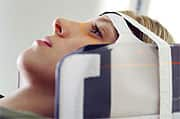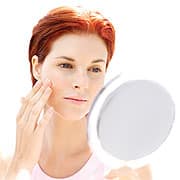Life Extension Magazine®
We all have a family member, a friend, or know someone who has experienced the dreaded side effects associated with cancer treatments. Life Extension® asked leading dermatologist Gary Goldfaden, MD, to discuss the unsightly, irritating, and sometimes painful dermatological problems that can accompany cancer treatment to see what can be done about them. This article describes the many side effects of cancer therapies that occur in the skin and what specific nutrients and compounds can be used to expedite a resolution. The most common treatment options for cancer patients today are surgery, radiation, and chemotherapy. More than half of all people diagnosed with cancer are treated with radiation therapy.1 This practice involves exposing the affected area to high-energy rays that kill the cancer cells and keep them from growing and multiplying.2 Radiation therapy can cause mild to severe skin reactions, including itchiness and redness, peeling and flaking, and even permanent scarring and pigmentation of the treated area.3,4 Chemotherapy uses drugs that target and kill rapidly dividing cells. Since cancer cells divide more rapidly than most cells, they are particularly susceptible to this kind of attack. However, there are healthy cells that also reproduce very rapidly, making them prime targets for chemotherapy-induced death as well. These include the cells that line the inside of your mouth, the lining of your intestines, your blood cells, platelets, hair follicles, and your skin cells.5 This accounts for many of the side effects experienced during chemotherapy, including hair loss, nausea, and low blood cell counts.6 Skin problems, including rashes, peeling, discoloration, streaking, bruising, extreme dryness, sensitivity, redness, and acne, are also a common result of chemotherapy.7 Fortunately, there are safe, effective, natural nutrients that can alleviate these skin-related side effects of cancer treatment: vitamin K1, vitamin D, extract of the European flowering plant Arnica montana (arnica), oats, and concentrated tea extracts. Topically combined, they help to speed the repair and regeneration of damaged skin resulting from the effects of cancer surgery, radiation, and chemotherapy. Pre- and Post-Surgical Topical TreatmentTopically treating the site before a surgical procedure with powerful antioxidants, such as concentrated tea extracts, along with natural anti-inflammatory, moisturizing compounds contained in oats called avenanthramides, can help strengthen your skin’s natural defenses.8,9 Post-operatively, applying the fat-soluble clotting factor vitamin K1 helps to restore damaged skin’s ability to heal from bruising.10,11 Topical arnica applied to the wound site can also reduce post-operative bruising and swelling.12,13 At the same time, vitamin D helps to speed skin regeneration,14,15 thereby minimizing the risk of surgery-induced scarring and skin discoloration. Support from the Effects of Radiation Therapy
Again, pre-treating the skin site with natural, health-promoting antioxidants prior to radiation therapy can help to ensure a cosmetically favorable post-treatment outcome. After radiation therapy, the skin’s response usually undergoes three consecutive stages. In the first stage, the patient may experience itching and redness in the affected area. This irritation may be successfully countered through the combined effects of arnica’s anti-inflammatory action and the natural healing effect of vitamin D. As treatment progresses, second-stage symptoms often develop, including excessive dryness and sensitivity, along with peeling and flaking of the skin. Oats, with their potent moisturizing and anti-inflammatory properties, act to effectively calm, protect, and heal severely dehydrated skin at this stage.16 In the third and final stage, actual burning of the skin caused by radiation results in scarring17 and unwanted pigmentation. Treating the affected area with vitamin D and natural antioxidants such as concentrated tea extracts18,19 can help accelerate the regenerative process and reduce subsequent scarring. Healing Power for Bruising and EcchymosesChemotherapy can destroy the platelet-forming cells found in your bone marrow. Platelets are responsible for forming clots to halt internal bleeding. As this deterioration progresses and more platelets are lost, even the slightest trauma can provoke massive bruising that may take months to heal. If the patient’s platelet count drops to extremely low levels (a normal platelet count in a healthy individual is between 150,000-450,000 per microliter of blood), spontaneous bruising may occur without any trauma at all.20 The resulting ecchymoses—the technical term for large, reddish-blue patches of bruised skin—may also be caused by the rupture of small blood vessels. Both of these conditions can be effectively treated with vitamin K1.10,11,21 The compounds found in arnica have been shown to reduce swelling, quell inflammation, and speed the skin’s recovery from hematoma.22-25 Vitamin K1 is also ideal as a treatment for most kinds of vascular injury due to its fat-soluble nature and powerful blood-clotting effects.26 When topically applied, vitamin K1 readily penetrates the skin and travels deep into the inner layer of the skin known as the dermis, where it effectively targets damaged capillaries. Vitamin K1 and arnica also naturally help resolve bruising.26
Combating “Venous Streaking” and “Extravasation”One of the more common side effects of chemotherapy is called venous flare or venous streaking.27 This mild allergic reaction is characterized by a localized redness or rash (often accompanied by itching) that runs along the path of the injected vein. Venous streaking physically resembles but should not be confused with extravasation, the accidental administration of intravenously (IV) infused medicinal drugs into surrounding healthy tissue. Venous streaking may be effectively minimized by applying a combination of natural antioxidants to the injection site—including arnica and vitamin K—both before and after chemotherapy.
Extravasation refers to the escape of a chemotherapy drug into the extravascular space, either by leakage from a vessel or by direct infiltration. Extravasation is a more severe kind of dermal injury that can result in long-term pain and swelling. A little-used but effective antidote for chemotherapy extravasation injury is the topical application of a 70% DMSO solution with a white cotton swab to the affected area. Any excess DMSO should be removed with a white cotton cloth or tissue. Treatment may be repeated every 3-4 hours and may be needed for four to eight weeks to completely resolve the extravasation injury.28 Soothing Dry, Sensitive, Fragile, and Peeling SkinDry, rough, flaky skin is often a side effect of chemotherapy drugs for two main reasons: 1) the drugs destroy new skin cells; and 2) the drugs interfere with the normal function of your skin’s naturally moisturizing and protective oil and sweat glands.29 Extreme dehydration may manifest in affected areas, resulting in a range of side effects, from painful cracks that may or may not bleed, to intense itching, redness, and inflammation. As a major controlling factor in skin cell growth and replacement, vitamin D can help to counter these effects. The rate at which new cells divide, the nature and timing of their changes, as well as their transit time to the skin’s surface, are all triggered and controlled by the presence of vitamin D.30,31 The powerful antioxidant and anti-inflammatory effects of oats can also help to reduce redness and irritation. Countering Steroid-Induced Acne Outbreaks
Some of the more effective and commonly used agents employed as part of the cancer treatment regimen are steroids—a class of hormones that unfortunately may lead to an outbreak of acne. This happens because steroids increase the activity of oil glands in the skin. This is where oats come in. In addition to quelling inflammation, oats act as a natural astringent. They effectively draw excess oil out of the skin and help clear clogged pores. They also act as a natural exfoliant that gently rubs away dead skin cells and other debris as they increase blood circulation to aid skin regeneration.32,33 SummaryThe most common cancer treatments, including surgery, radiation, and chemotherapy, produce unsightly, irritating, and often painful skin reactions. Surgery and radiation inflict physical damage to the skin in the form of trauma, rupture, and burning. Chemotherapy, which kills rapidly dividing cancer cells, also destroys healthy cells that divide rapidly—including skin cells. The fat-soluble nutrient vitamin K1 restores the skin’s diminished healing ability caused by chemotherapy’s attack of blood platelets. Extract of the European flowering plant Arnica montana exerts a powerful anti-inflammatory and anti-itching effect. The antioxidants in concentrated tea extracts bolster your skin’s free-radical defenses. The anti-inflammatory, moisturizing compounds found in oats called avenanthramides help to soothe traumatized skin and speed regeneration. Oats also act as gentle astringents and exfoliants, clearing away excess dead skin cells. Vitamin D helps to accelerate skin regeneration. When topically combined, they effectively protect skin prior to cancer treatment and speed post-treatment healing and recovery. The anti-inflammatory, moisturizing compounds found in oats called avenanthramides help to soothe traumatized skin and speed regeneration. If you have any questions on the scientific content of this article, please call a Life Extension® Health Advisor at 1-866-864-3027. | |||||||
| References | |||||||
| 1. Available at: http://www.astro.org/PressRoom/FastFacts/documents/FFAboutRT.pdf. Accessed December 21, 2010. 2. Available at: http://www.medicinenet.com/radiation_therapy/article.htm. Accessed December 21, 2010. 3. Available at: http://www.cancer.gov/cancertopics/coping/radiation-therapy-and-you/page6. Accessed December 21, 2010. 4. Available at: http://www.wrongdiagnosis.com/s/skin_cancer/treatments.htm. Accessed December 21, 2010. 5. Available at: http://www.cancer.gov/cancertopics/chemotherapy-and-you/allpages. Accessed December 21, 2010. 6. Available at: http://www.driscollchildrens.org/health/peds/oncology/cantreat.asp. Accessed December 21, 2010. 7. Available at: http://www.chemocare.com/managing/skin_reactions.asp. Accessed December 21, 2010. 8. Dimberg LH, Theander O, Lingert H. Avenanthramides – A group of phenolic antioxidants in oats. Cereal Chem. 1993;70(6):637-41 9. Sur R, Nigam A, Grote D, Liebel F, Southall MD. Avenanthramides, polyphenols from oats, exhibit anti-inflammatory and anti-itch activity. Arch Dermatol Res. 2008 Nov;300(10):569-74. 10. Shah NS, Lazarus MC, Bugdodel R, et al. The effects of topical vitamin K on bruising after laser treatment. J Am Acad Dermatol. 2002 Aug;47(2):241-4. 11. Lou WW, Quintana AT, Geronemus RG, Grossman MC. Effects of topical vitamin K and retinol on laser-induced purpura on nonlesional skin. Dermatol Surg. 1999 Dec;25(12):942-4. 12. Leu S, Havey J, White LE, et al. Accelerated resolution of laser-induced bruising with topical 20% arnica: a rater-blinded randomized controlled trial. Br J Dermatol. 2010 Sep;163(3):557-63. 13. Seeley BM, Denton AB, Ahn MS, Maas CS. Effect of homeopathic Arnica montana on bruising in face-lifts: results of a randomized, double-blind, placebo-controlled clinical trial. Arch Facial Plast Surg. 2006 Jan-Feb;8(1):54-9. 14. Zasloff M. Sunlight, vitamin D, and the innate immune defenses of the human skin. J Invest Dermatol. 2005;125(5):xvi-xvii. 15. Ganz T. Defensins: antimicrobial peptides of vertebrates. C R Biol. 2004 Jun;327(6):539-49. 16. Available at: http://www.activenaturalsinstitute.com/anri/library_avenanthramides.html. Accessed December 22, 2010. 17. Available at: http://www.healthcastle.com/se_radiation.shtml. Accessed December 22, 2010. 18. Katiyar S, Elmets CA, Katiyar SK. Green tea and skin cancer: photoimmunology, angiogenesis and DNA repair. J Nutr Biochem. 2007 May;18(5):287-96. 19. Marnewick J, Joubert E, Joseph S, Swanevelder S, Swart P, Gelderblom W. Inhibition of tumour promotion in mouse skin by extracts of rooibos (Aspalathus linearis) and honeybush (Cyclopia intermedia), unique South African herbal teas. Cancer Lett. 2005 Jun 28;224(2):193-202. 20. Available at: http://www.medicinenet.com/thrombocytopenia_low_platelet_count/article.htm. Accessed December 21, 2010. 21. Guidry JR, Raschke RA, Morkunas AR. Toxic effects of drugs used in the ICU. Anticoagulants and thrombolytics. Risks and benefits. Crit Care Clin. 1991 Jul;7(3):533-54. 22. Lyss G, Schmidt TJ, Merfort I, Pahl HL. Helenalin, an anti-inflammatory sesquiterpene lactone from Arnica, selectively inhibits transcription factor NF-kappaB. Biol Chem. 1997 Sep;378(9):951-61. 23. Schmidt TJ. Helenanolide-type sesquiterpene lactones--III. Rates and stereochemistry in the reaction of helenalin and related helenanolides with sulfhydryl containing biomolecules. Bioorg Med Chem. 1997 Apr;5(4):645-53. 24. Kupchan SM, Eakin MA, Thomas AM. Tumor inhibitors. 69. Structure-cytotoxicity relationships among the sesquiterpene lactones. J Med Chem. 1971 Dec;14(12):1147-52. 25. Lee KH, Meck R, Piantadosi C, Huang ES. Antitumor agents. 4. Cytotoxicity and in vitro activity of helenalin esters and related derivatives. J Med Chem. 1973 Mar;16(3):299-301. 26. Available at: http://www.freepatentsonline.com/5510391.html. Accessed December 22, 2010. 27. Hayden BK, Goodman M. Chemotherapy: Principles of Therapy. In: Yarbro CH, Frogge MH, Goodman M. Cancer Nursing: Principles and Practice.6th ed. Jones & Bartlett Publishers, Inc.; 2005:361-411. 28. Available at: http://www.dmso.org/articles/skkin/softiss.htm. Accessed January 5, 2011. 29. Available at: http://www.breastcancer.org/tips/hair_skin_nails/skin_care.jsp. Accessed December 22, 2010. 30. Matsumoto K, Azuma Y, Kiyoki M, Okumura H, Hashimoto K, Yoshikawa K. Involvement of endogenously produced 1,25-dihydroxyvitamin D-3 in the growth and differentiation of human keratinocytes. Biochim Biophys Acta. 1991 May 17;1092(3):311-8. 31. Holick MF, MacLaughlin JA, Clark MB, et al. Photosynthesis of previtamin D3 in human skin and the physiologic consequences. Science. 1980 Oct 10;210(4466):203-5. 32. Cerio R, Dohil M, Jeanine D, Magina S, Mahé E, Stratigos AJ. Mechanism of action and clinical benefits of colloidal oatmeal for dermatologic practice. J Drugs Dermatol. 2010 Sep;9(9):1116-20. 33. Kurtz ES, Wallo W. Colloidal oatmeal: history, chemistry and clinical properties. J Drugs Dermatol. 2007 Feb;6(2):167-70. |






